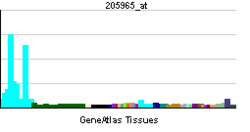BATF (gene)
Basic leucine zipper transcription factor, ATF-like, also known as BATF, is a protein which in humans is encoded by the BATF gene.[1][2][3]
Function
The protein encoded by this gene is a nuclear basic leucine zipper (bZIP) protein that belongs to the AP-1/ATF superfamily of transcription factors. The leucine zipper of this protein mediates dimerization with members of the Jun family of proteins. This protein is thought to be a negative regulator of AP-1/ATF transcriptional events.[3]
Mice without the BATF gene (BATF knockout mice) lacked a type of inflammatory immune cell (Th17) and were resistant to conditions that normally induces an autoimmune condition similar to multiple sclerosis.[4]
Interactions
BATF (gene) has been shown to interact with IFI35.[5]
References
- ↑ Dorsey MJ, Tae HJ, Sollenberger KG, Mascarenhas NT, Johansen LM, Taparowsky EJ (December 1995). "B-ATF: a novel human bZIP protein that associates with members of the AP-1 transcription factor family". Oncogene 11 (11): 2255–65. PMID 8570175.
- ↑ Hasegawa H, Utsunomiya Y, Kishimoto K, Tange Y, Yasukawa M, Fujita S (May 1996). "SFA-2, a novel bZIP transcription factor induced by human T-cell leukemia virus type I, is highly expressed in mature lymphocytes". Biochem. Biophys. Res. Commun. 222 (1): 164–70. doi:10.1006/bbrc.1996.0700. PMID 8630063.
- ↑ 3.0 3.1 "Entrez Gene: BATF basic leucine zipper transcription factor, ATF-like".
- ↑ Schraml BU, Hildner K, Ise W, Lee WL, Smith WA, Solomon B et al. (July 2009). "The AP-1 transcription factor Batf controls TH17 differentiation". Nature 460 (7253): 405–9. doi:10.1038/nature08114. PMC 2716014. PMID 19578362. Lay summary – eurekalert.org (2009-07-16).
- ↑ Wang X, Johansen LM, Tae HJ, Taparowsky EJ (1996). "IFP 35 forms complexes with B-ATF, a member of the AP1 family of transcription factors". Biochem. Biophys. Res. Commun. 229 (1): 316–22. doi:10.1006/bbrc.1996.1799. PMID 8954125.
Further reading
- Rual JF, Venkatesan K, Hao T, Hirozane-Kishikawa T, Dricot A, Li N et al. (2005). "Towards a proteome-scale map of the human protein-protein interaction network". Nature 437 (7062): 1173–8. doi:10.1038/nature04209. PMID 16189514.
- Deppmann CD, Thornton TM, Utama FE, Taparowsky EJ (2003). "Phosphorylation of BATF regulates DNA binding: a novel mechanism for AP-1 (activator protein-1) regulation". Biochem. J. 374 (Pt 2): 423–31. doi:10.1042/BJ20030455. PMC 1223616. PMID 12809553.
- Johansen LM, Deppmann CD, Erickson KD, Coffin WF, Thornton TM, Humphrey SE et al. (2003). "EBNA2 and Activated Notch Induce Expression of BATF". J. Virol. 77 (10): 6029–40. doi:10.1128/JVI.77.10.6029-6040.2003. PMC 154003. PMID 12719594.
- Williams KL, Zullo AJ, Kaplan MH, Brutkiewicz RR, Deppmann CD, Vinson C et al. (2003). "BATF transgenic mice reveal a role for activator protein-1 in NKT cell development". J. Immunol. 170 (5): 2417–26. doi:10.4049/jimmunol.170.5.2417. PMID 12594265.
- Echlin DR, Tae HJ, Mitin N, Taparowsky EJ (2000). "B-ATF functions as a negative regulator of AP-1 mediated transcription and blocks cellular transformation by Ras and Fos". Oncogene 19 (14): 1752–63. doi:10.1038/sj.onc.1203491. PMID 10777209.
- Meyer NP, Johansen LM, Tae HJ, Budde PP, Williams KL, Taparowsky EJ (1998). "Genomic organization of human B-ATF, a target for regulation by EBV and HTLV-1". Mamm. Genome 9 (10): 849–52. doi:10.1007/s003359900881. PMID 9745044.
- Wang X, Johansen LM, Tae HJ, Taparowsky EJ (1997). "IFP 35 forms complexes with B-ATF, a member of the AP1 family of transcription factors". Biochem. Biophys. Res. Commun. 229 (1): 316–22. doi:10.1006/bbrc.1996.1799. PMID 8954125.
- Hasegawa H, Utsunomiya Y, Kishimoto K, Tange Y, Yasukawa M, Fujita S (1996). "SFA-2, a novel bZIP transcription factor induced by human T-cell leukemia virus type I, is highly expressed in mature lymphocytes". Biochem. Biophys. Res. Commun. 222 (1): 164–70. doi:10.1006/bbrc.1996.0700. PMID 8630063.
- Dorsey MJ, Tae HJ, Sollenberger KG, Mascarenhas NT, Johansen LM, Taparowsky EJ (1996). "B-ATF: a novel human bZIP protein that associates with members of the AP-1 transcription factor family". Oncogene 11 (11): 2255–65. PMID 8570175.
External links
- BATF protein, human at the US National Library of Medicine Medical Subject Headings (MeSH)
- FactorBook BATF
This article incorporates text from the United States National Library of Medicine, which is in the public domain.
| ||||||||||||||||||||||||||||||||||||||||||||||||||||||||||||||||||||||||||||||||||||||||||||||||||||||||||||||||||||||||||||||||||||||||||||||||||||||||||||||||||||||||||||||||||||||||||||||||||||||||||||||
| ||||||||||
